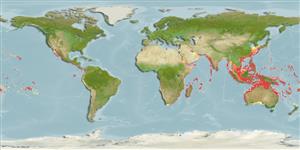Common names from other countries
Environment: milieu / climate zone / intervalo de profundidade / distribution range
Ecologia
marinhas associadas(os) a recifes; intervalo de profundidade 1 - 100 m (Ref. 48635). Tropical; 35°N - 37°S
Indo-Pacific: Red Sea and East Africa to the Hawaiian, Marquesan and Tuamoto islands, north to southern Japan and the Ogasawara Islands, south to Australia and New Zealand.
Tamanho / Peso / Idade
Maturidade: Lm ? range ? - ? cm
Max length : 40.0 cm TL macho/indeterminado; (Ref. 3392); common length : 20.0 cm TL macho/indeterminado; (Ref. 3392); peso máx. Publicado: 383.00 g (Ref. 132231)
Espinhos dorsais (total) : 7; Raios dorsais moles (total) : 9; Espinhos anais: 0; Raios anais moles: 6 - 7. Heavily armored box-like body and wing-like pectoral fins (Ref. 37816).
Body shape (shape guide): elongated; Cross section: circular.
Inhabit coastal waters with sandy substrates (Ref. 1602, 48635); a shallow-living species, benthic in adults; only species found in oceanic islands (Ref. 27821). Solitary, well-camouflaged and slow-moving (Ref. 37816, 48635). Feed on crustaceans, clams, and small fish. May be caught using ring nets (Ref. 5213).
Life cycle and mating behavior
Maturidade | Reprodução | Desova | Ovos | Fecundidade | Larvas
Paxton, J.R., D.F. Hoese, G.R. Allen and J.E. Hanley, 1989. Pisces. Petromyzontidae to Carangidae. Zoological Catalogue of Australia, Vol. 7. Australian Government Publishing Service, Canberra, 665 p. (Ref. 7300)
Categoria na Lista Vermelha da IUCN (Ref. 130435: Version 2025-1)
Ameaça para o homem
Harmless
Utilização humana
Pescarias: pouco comercial; Aquário: Espécies comerciais
Ferramentas
Relatórios especiais
Descarregue XML
Fontes da internet
Estimates based on models
Preferred temperature (Ref.
123201): 23.3 - 29, mean 27.8 °C (based on 1738 cells).
Phylogenetic diversity index (Ref.
82804): PD
50 = 0.5235 [Uniqueness, from 0.5 = low to 2.0 = high].
Bayesian length-weight: a=0.00550 (0.00229 - 0.01319), b=3.09 (2.88 - 3.30), in cm total length, based on LWR estimates for this (Sub)family-body shape (Ref.
93245).
Nível Trófico (Ref.
69278): 3.7 ±0.55 se; based on food items.
Generation time: 0.7 ( na - na) years. Estimated as median ln(3)/K based on 1
growth studies.
Resiliência (Ref.
120179): Elevada, tempo mínimo de duplicação da população menor que 15 meses (K=1.5).
Fishing Vulnerability (Ref.
59153): Low vulnerability (18 of 100).
🛈
Nutrients (Ref.
124155): Calcium = 86.6 [38.6, 195.6] mg/100g; Iron = 0.876 [0.407, 2.444] mg/100g; Protein = 18 [16, 20] %; Omega3 = 0.142 [0.060, 0.444] g/100g; Selenium = 70.6 [30.3, 174.1] μg/100g; VitaminA = 29.6 [9.4, 93.3] μg/100g; Zinc = 1.27 [0.80, 1.93] mg/100g (wet weight);
